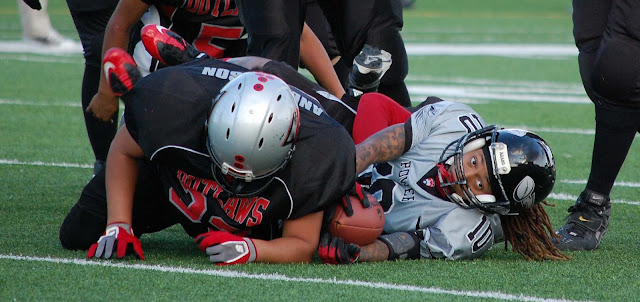Lily came up with a cool drill for her line. It is the kind of thing you do when your budget won't buy a blocking sled. Push a truck. It builds strength and makes a point. The point is you have more power with a low profile. You want head and shoulders higher than hips, back fairly straight. But this posture produces power.
I've been screaming (softly) at television images of the pros and college players missing tackles. Seems at that level of play they should rarely miss. But even at that level they seem to go high, grab for the runner's shoulders and try to wrestle him to the ground.
No no no no no no no! Get low. Shoulder into belt buckle. And wrap the runner up, shoulder in middle and arms wrapping around the legs.
 |
| Go low. Grab the legs. Runners can run fast with dragging a two-hundred pound tackler. |
The photo here isn't a perfect illustration but the tackler is low and is wrapping arms around runner legs. Low.
Tackling dummies have been around forever to help football players practice tackling without having to hit teammates. Tackling dummies are about four feet high, while people are closer to six feet. What does that tell you? It tells you designers of tackling dummies expect tacklers to hit the lower part of the runner's body.The Outlaws share their practice field with a men's team, the Austin Wolfpack. At one of the Wolfpack practices, I did some photos of the guys practicing tackling on the tackling dummy. The photos are kind of fun. I'd like it better if they got even lower but you can see there is a tremendous amount of power in these hits.
 |
| The ball you see in this picture had been placed on top of the dummy. I think coach set it there to make the point you hit the runner below the ball. In his middle. |
 |
| Big guy. You wanna bet whether he'd bring the runner down. He is hitting low because the tackling dummy is only four feet high. A whole lot of power in that hit. |
 |
| Tackler isn't so big but he's driving through the dummy. |
Now I'm going to get in a little trouble. After shooting the Wolfpack abusing the tackling dummy, I thought I'd like to get some photos of Outlaws doing likewise. And I didn't do so well. I did get them working the dummies but somehow this lacks some of the energy I saw in the guy's practice.
 |
| Low, engaging the dummy, but I don't think there is much power in these hits. |
Remember I'm not a coach. Also remember that some photos distort whatever is happening on the field. I suspect there's a really good reason for this drill. Certainly the Outlaws are getting low as they engage the four-foot dummy. But beyond that, I'm not sure what is going on. I liked it better the way the Wolfpack did it.





























.jpg)















